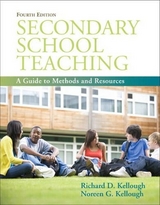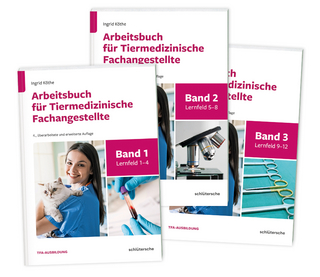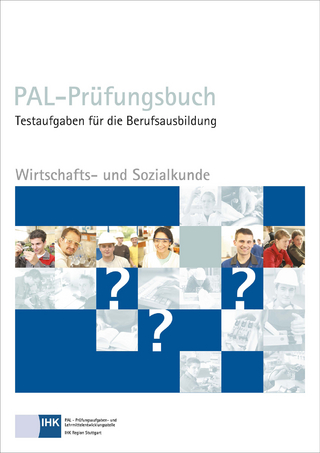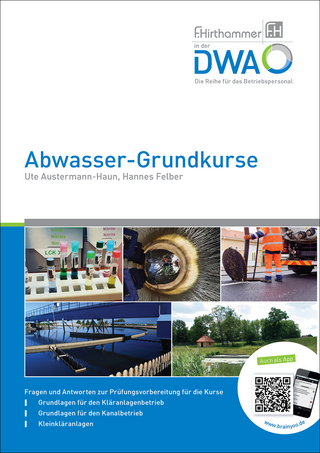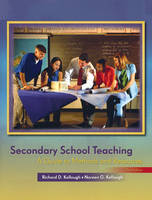
Secondary School Teaching
Pearson (Verlag)
978-0-13-170930-0 (ISBN)
- Titel erscheint in neuer Auflage
- Artikel merken
Contents
(Each chapter ends with the following features -- Summary, Questions for Class Discussion, Websites Related to the Content of This Chapter, For Further Reading)
CHAPTER 1 Secondary School Teaching Today: Recognizing and understanding the Challenge
Understanding the Challenge
The Classroom in a Nation of Diversity and Shifting
Demographics: Understanding Your Challenge
Orientation: No Single Shoe Fits All
Exercise 1.1: What Message is Being Conveyed?
Middle Level Schools
High Schools
The Fundamental Characteristic of Quality Education
Exercise 1.2: Conversation with a Classroom Teacher
The Community Served by the School
The Emergent Overall Picture: Current Actions, Trends, Problems, and Issues
Meeting the Challenge: Recognizing and Providing For Student Differences
Reviewing the Developmental Characteristics of Children of Particular Age Groups
Exercise 1.3: Obtaining Personal Insight Regarding the Age or Grade Level I Might Prefer to Teach
CHAPTER 2 Teacher Professional Responsibilities
The Teacher as a Reflective Decision Maker
Reflection, Locus of Control, Sense of Self Efficacy, and Teacher Responsibility
Exercise 2.1: The Teacher as Reflective Decision Maker
Exercise 2.2: Reflective Decision Making: The Preactive Phase of Instruction
Selected Legal Guidelines
Teaching Style
Exercise 2.3: Using Observation of Classroom Interaction to Analyze One Teacher's Style
Exercise 2.4: Using a Questionnaire to Develop a Profile and a Statement About My Own Tchg Style
Commitment and Professionalism
Exercise 2.5: Reviewing the Professional Responsibilities of a First-Year Teacher
Identifying and building Your Instrucational Competencies
Teacher Behaviors Necessary to Facilitate Student Learning
Tools for Instruction
CHAPTER 3 Thinking and Questioning: Skills for Meaningful Learning
Teaching Thinking for Intelligent Behavior
Purposes for using Questioning
Types of Cognitive Questions: A Glossary
Socratic Questioning
Levels of Cognitive Questions and Student Thinking
Exercise 3.1: Identifying the Cognitive Levels of Questions- A Self Check Exercise
Guidelines for using Questioning
Exercise 3.2: Think Time and the Art of Questioning: An In-Class Exercise
Questions from Students: The Question-Driven Curriculum
Exercise 3.3: Examining Course Materials for Level of Questioning
Exercise 3.4: Observing the Cognitive Levels of Classroom Verbal Interaction
Exercise 3.5: Practice in Raising Questions to Higher Levels
Exercise 3.6: Creating Cognitive Questions
Exercise 3.7: A Cooperative Learning and Micro Peer Teaching Exercise in the use of Questioning-- Micro Peer Teaching I
CHAPTER 4 The Classroom Learning Environment: The Importance of Perceptions
Classroom Control- Its Meaning - Past and Present
Developing Your own Approach to Classroom Management
Providing a Supportive Learning Environment
Preparation Provides Confidence and Success
Exercise 4.1: Observing a Classroom for Frequency of External Interruptions
Exercise 4.2: Teachers' Classroom Management Systems
Exercise 4.3: Beginning the Development of My Classroom Management System
Using Positive Rewards as Motivators
Managing Class Sessions
Exercise 4.4: Observation and Analysis of How Experienced Teachers Open Class Sessions
Inappropriate Student Behavior
Teacher Response to Student Misbehavior
Teacher-Caused Student Misbehavior
Exercise 4.5: Avoiding Sending Opposing Messages
Exercise 4.6: Indentifying Teacher Behaviors That Cause Student Misbehavior- A Self-Check
Situational Case Studies for Additional Review
CHAPTER 5 The Curriculum: Selecting and Setting Learning Expectations
Program Organization: Providing Successful Transitions
Curriculum and Instruction: Clarification of Terms
Planning for Instruction: Three Levels
Curriculum Standards
Exercise 5.1: Examining National Curriculum Standards
Exercise 5.2: Examining State Curriculum Standards
Exercise 5.3: Examining State Curriculum Frameworks
Exercise 5.4: Examining Local Curriculum Documents
Student Textbooks
Exercise 5.5: Examining Student Textbooks and Teacher's Editions
Beginning to Think About the Sequencing of Content
Exercise 5.6: Preparing a Full Semester Course Outline
Preparing For and Dealing with Controversy
Exercise 5.7A: Dealing with Controversial Content and Issues
Exercise 5.7B: Censorship: Books That are Sometimes Challenged
Aims, Goals, and Objectives: The Anticipated Learning Outcomes
Learning Outcomes
Preparing Instructional Objectives
Exercise 5.8: Recognizing Verbs That Are Acceptable For Overt Objectives- A Self-Check
Exercise 5.9: Recognizing the Parts of Criterion-Referenced Instructional Ojectives - A Self-check
Exercise 5.10: Recognizing Objectives That Are Measurable- A Self Check
Exercise 5.11: Recognition of Cognitive, Affective, and Psychomotor Objectives- A Self-Check
Exercise 5.12:Preparing My Own Instructional Objectives
Learning That Is Not Immediately Observable
Integrated Curriculum
Planning for Instruction: A Seven-Step Process
The Syllabus
CHAPTER 6 Planning the Instruction
The Instructional Unit
Theoretical Considerations for the Selection of Instructional Strategies
Selecting Learning Activities That Are Developmentally Appropriate
Styles of Learning and Implications for Teaching
The Learning Experiences Ladder
Planning and Developing an Interdisciplinary Thematic Unit
Preparing Lesson Plans
Constructing A Lesson Plan: Format, Elements, and Samples
Setting the Learning Objectives
Exercise 6.1: Analysis of a Lesson That Failed
Exercise 6.2A: Preparing a Lesson Plan
Exercise 6.2B: Self and Peer Assessment of My Lesson Plan
Exercise 6.3: Preparing an Instructional Unit: Bringing It All Together
CHAPTER 7 Assessing and Reporting Student Achievement
Purposes and Principles of Assessment
The Language of Assessment
Assessing Student Learning: Three Avenues
Student Involvement in Assessment
Maintaining Records of Student Achievement
Grading and Marking Student Achievement
Testing For Achievement
Preparing Assessment Items
Assessment Items: Descriptions, Examples, and Guidelines for Preparing and Using 12 Types
Exercise 7.1: Preparing Assessment Items
Reporting Student Achievement
Teacher Parental/Guardian Connections
CHAPTER 8 The Thinking Curriculum: Using Teacher Talk, Demonstrations, Inquiry and Games
Teacher Talk: Formal and Informal
Exercise 8.1: The Lecture-Summary Review and Practice Demonstration
Inquiry Teaching and Discovery Learning
Integrating Strategies for Integrated Learning
Exercise 8.2: A Study of Inquiry and Strategy Integration
Educational Games
Exercise 8.3: Developing A Lesson Using Level II Inquiry, Thinking Skill A Development, Demonstration, or an Interactive Lecture- Micro Peer Teaching II
CHAPTER 9 Organizing and Guiding Student Learning: Alone and In Groups
Mastery Learning and Personalized Instruction
Working With and Individualizing the Learning Experiences for Specific Learners
Learning Alone
Learning in Pairs
Learning in Small Groups
Cooperative Learning
Learning in Large Groups
Exercise 9.1A: Whole-Class Discussion As a Teaching Strategy: What Do I Already Know?
Exercise 9.1B: Whole-Class Discussion As a Teaching Strategy: Building Upon What I Already Know
Equity in The Classroom
Exerciese 9.2: Teacher Interaction With Students According to Student Gender
Learning From Assignments and Homework
Project-Centered Learning: Guiding Learning From Independent and Group Investigations, Papers, and Oral Reports
Writing Across the Curriculum
A Collection of More Than 125 Annotated Motivational Teaching Strategies with Ideas for Lessons, Iinterdisciplinary Teaching, Transcultural Studies, and Student Projects
CHAPTER 10 Professional Development: A Continuing Process
Professional Development Through Student Teaching or Internship
Finding a Teaching Position
Professional Development Through Reflection and Self-Assessment
Professional Development Through Mentoring
Professioanl Development Through Inservice and Graduate Study
Professional Development Through Participation in Professional Organizations
Professional Development Through Communications with Teachers
Professional Development Through Off-Teaching Work Experience
Professional Development Through Micro Peer Teaching
Exercise 10.1: Pulling It All Together: Micro Peer Teaching III
GLOSSARY
REFERENCES
INDEX
| Erscheint lt. Verlag | 22.3.2006 |
|---|---|
| Sprache | englisch |
| Gewicht | 676 g |
| Themenwelt | Sozialwissenschaften ► Pädagogik ► Berufspädagogik |
| Sozialwissenschaften ► Pädagogik ► Schulpädagogik / Sekundarstufe I+II | |
| ISBN-10 | 0-13-170930-5 / 0131709305 |
| ISBN-13 | 978-0-13-170930-0 / 9780131709300 |
| Zustand | Neuware |
| Informationen gemäß Produktsicherheitsverordnung (GPSR) | |
| Haben Sie eine Frage zum Produkt? |
aus dem Bereich
